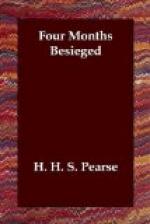January 24.—All day long I have watched from Observation Buller’s batteries shelling the whole range of Intaba Mnyama from the peaked “paps” or “sisters,” past the Kloof north-west of them, and along the more commanding Hog’s Back. The Boers call part of this range Spion Kop, and that name has been adopted by our Intelligence Staff as presenting less difficulties of orthography than the Zulu designation. So Spion Kop it must be henceforth. From a laager behind one peak I saw an ambulance cart with its Red Cross flag go up to the crest, which seemed a dangerous place for it, especially as a piece of light artillery opened beside the cart a moment later. I could see needles of light flashing out like electric sparks, only redder, but could hear no report. Nothing but a “Pom-Pom” could have made those quivering flashes, yet how it got there with an ambulance cart beside it I must leave the Boers to explain. The shelling of heights with Lyddite and shrapnel went on hour after hour, and towards evening some thought they heard a faint sound as of rifle volleys. The Boers came hurrying down in groups from Spion Kop’s crest, their waggons were trekking from laagers across the plain towards Van Reenan’s, and men could be seen rounding up cattle as if for a general rearward movement. To us watching it seemed as if the Boers were beaten and knew it.
January 25.—The Boer trek continued for several hours this morning and well on into the afternoon, when it slackened. Then we saw some horsemen turn back to make for the cleft ridge of Doorn Kloof, where one of the big Creusots had opened fire, Buller’s naval guns or howitzers replying with Lyddite shells. The roar of our field-guns has died away instead of drawing nearer, and we look in vain for any sign of British cavalry on the broad plain, where they should be by now if Sir Redvers Buller’s infantry attack had succeeded.
January 26.—The Boers are back in their former laagers. There is no sound of fighting this side of the Tugela, only a few shells falling on Spion Kop, where Boer tents can be seen once more whitening the steep. We need no heliograph signal to tell us the meaning of all this. For us there is to be another sickening period of hope deferred; but we try to hide our dejection, and persuade the anxious townsfolk that it is only a necessary pause while General Buller brings up his big guns and transport.
January 28.—It is now no longer possible to conceal the fact that the fight on Spion Kop ended in another reverse for General Buller, though from our side it seemed as if he had the enemy beaten and demoralised. It is now published in orders that he captured the heights with part of one brigade which, however, retired after General Woodgate was wounded, when the Boers retook it. From Kaffir runners we hear another version which makes out that our troops were complete masters of the situation if there had been any one in command at that moment,




